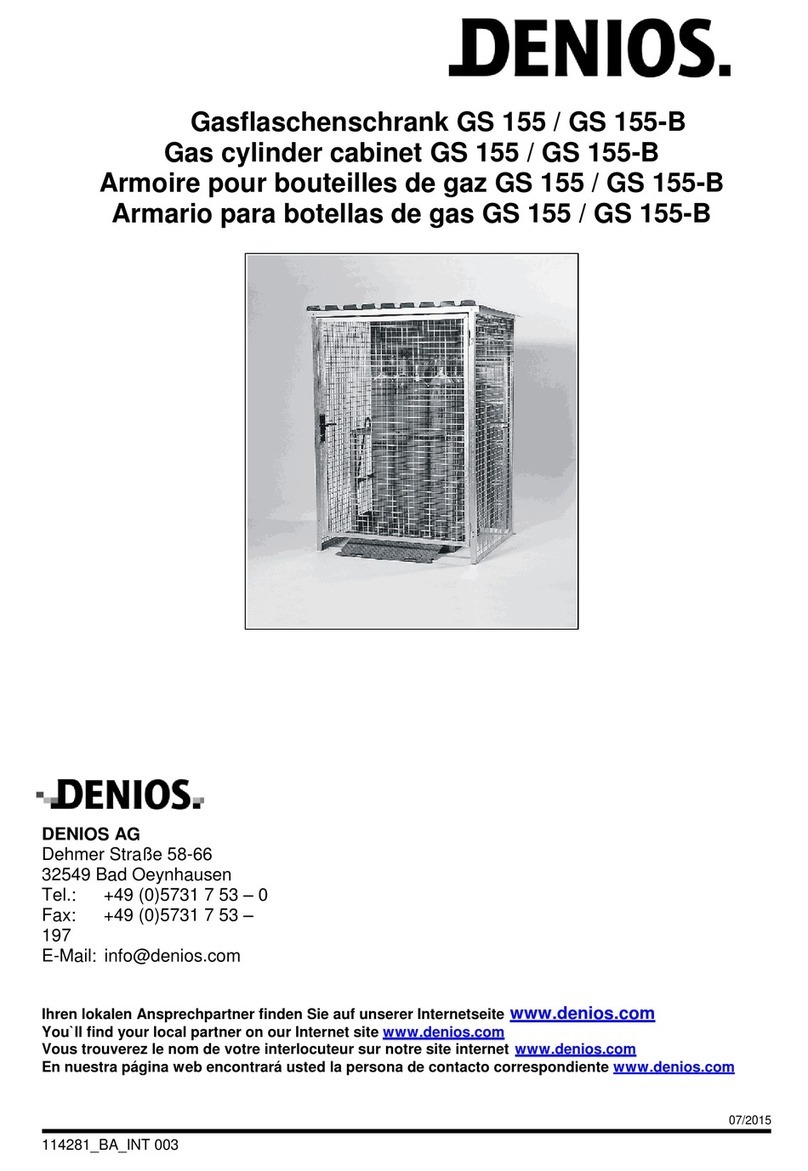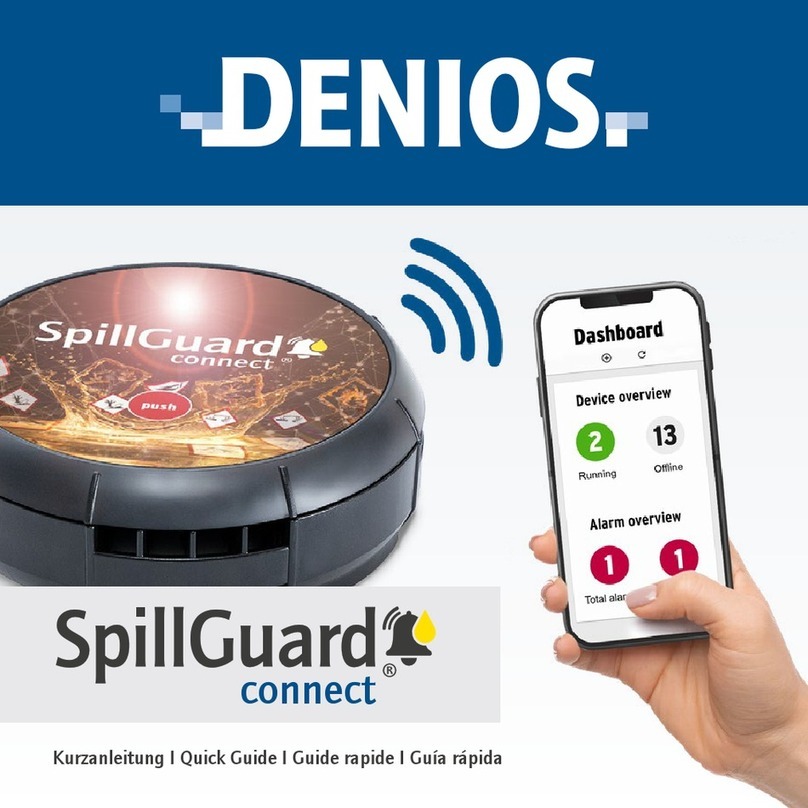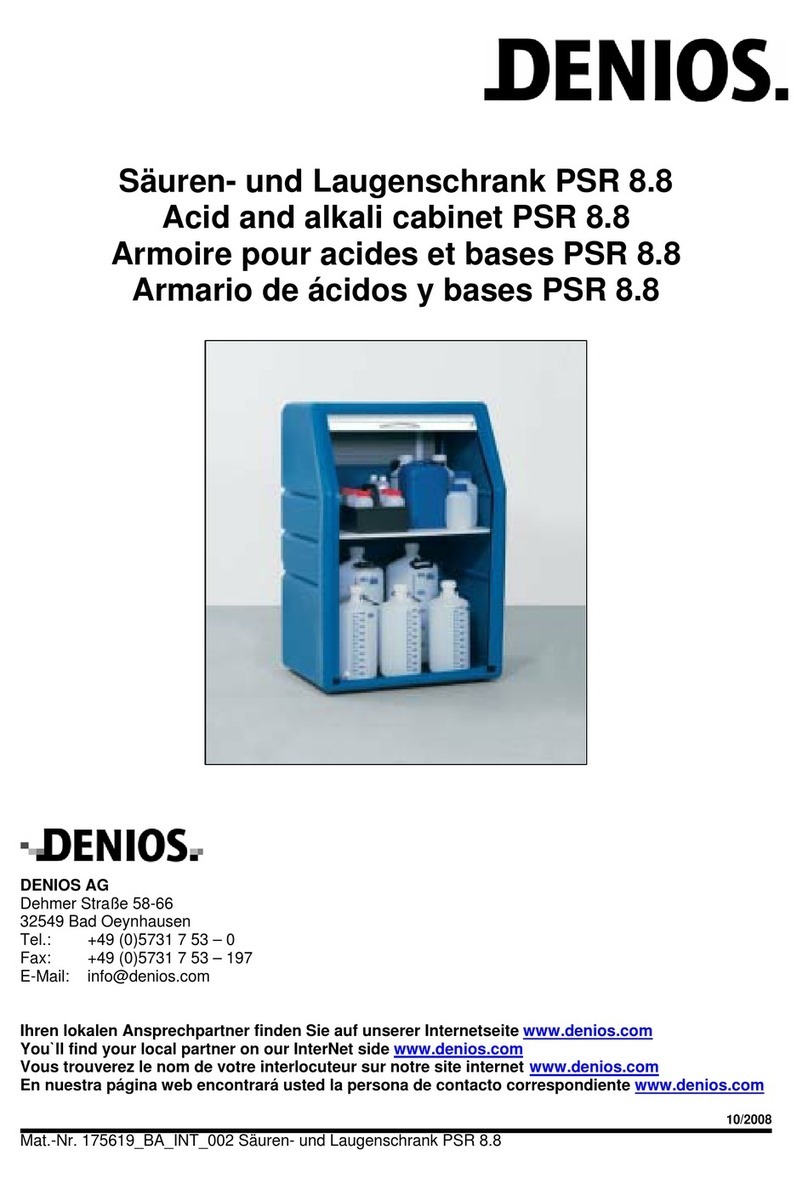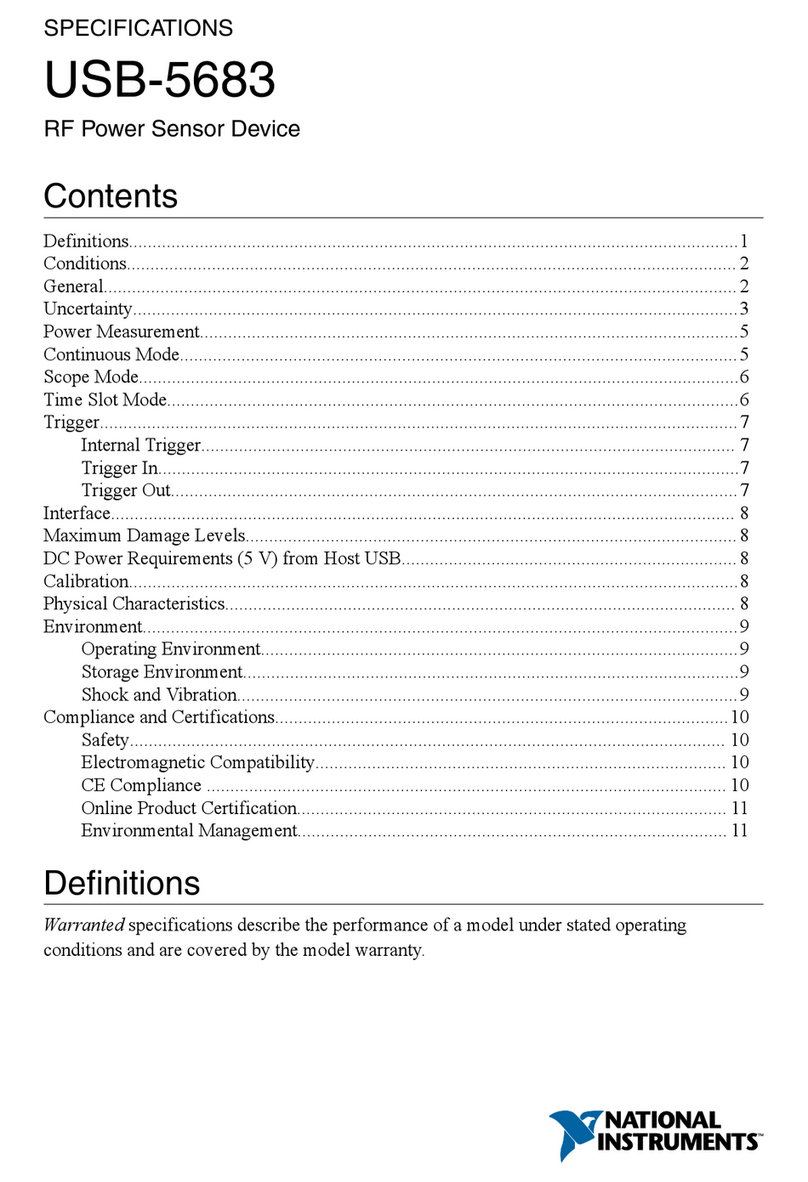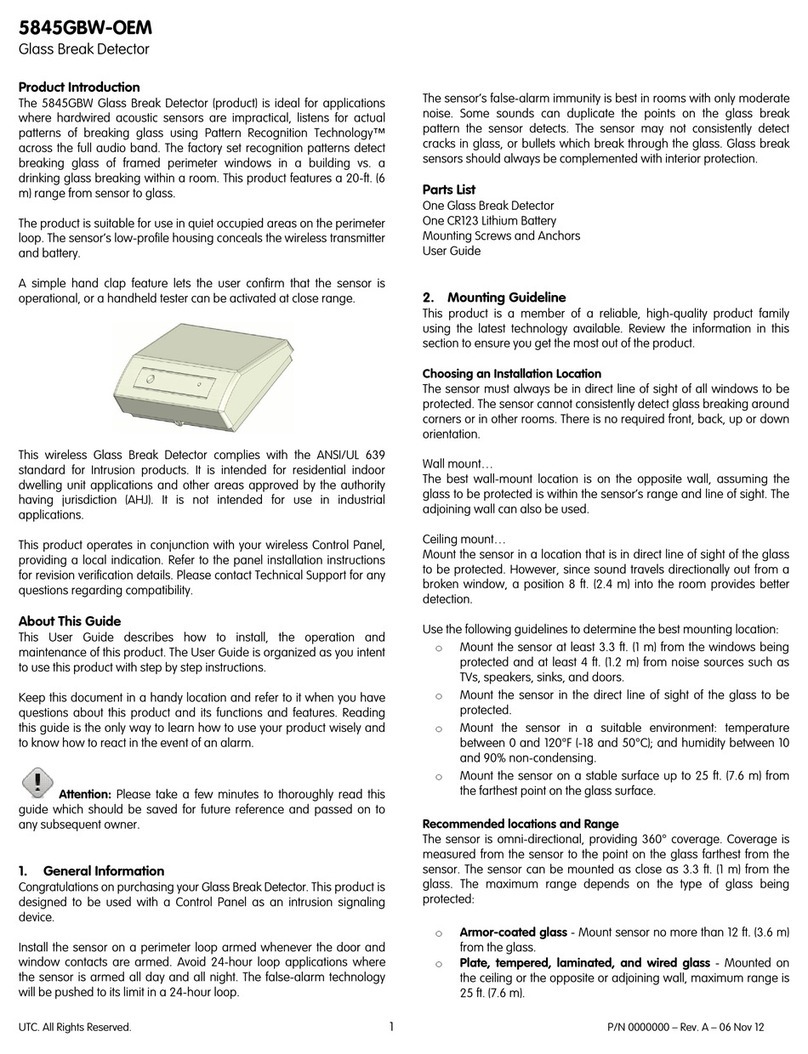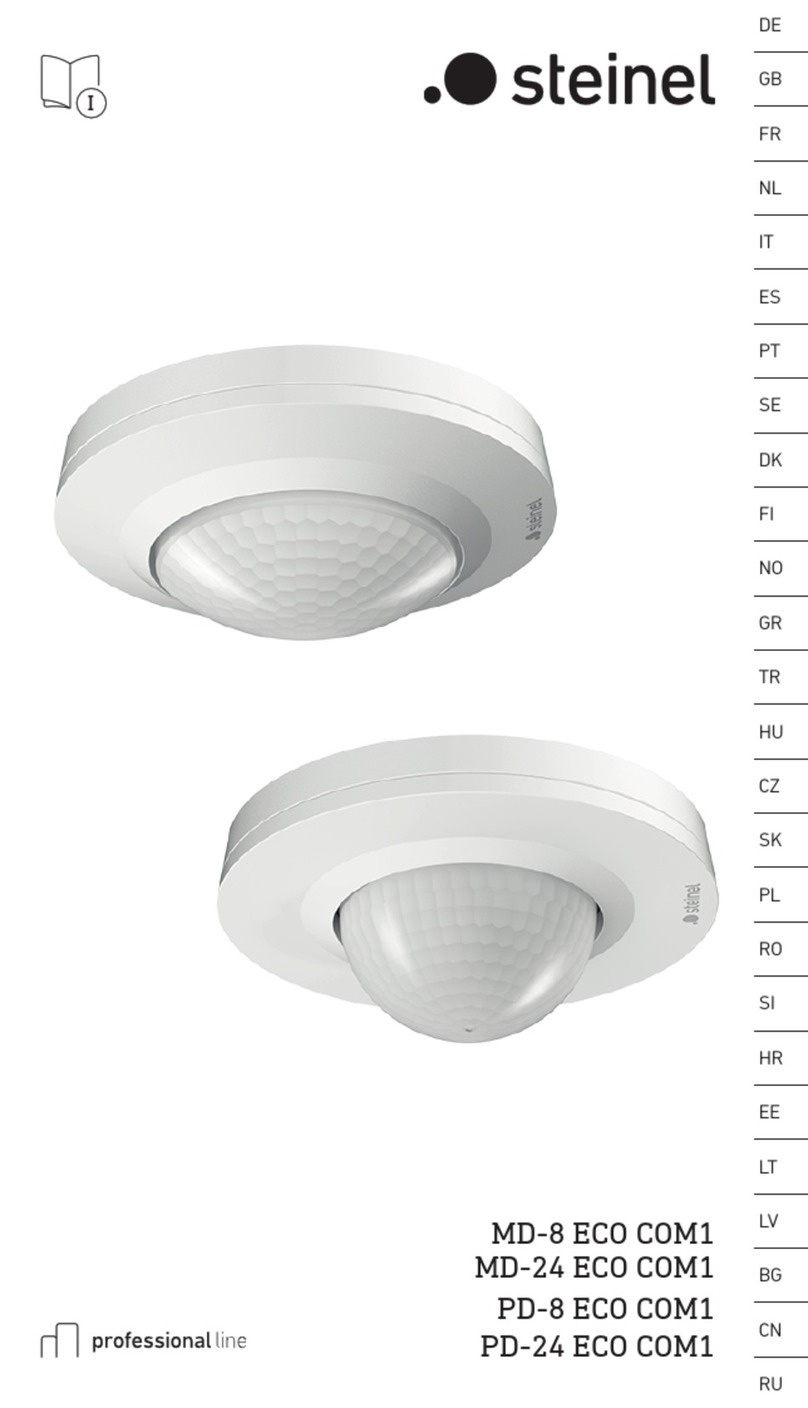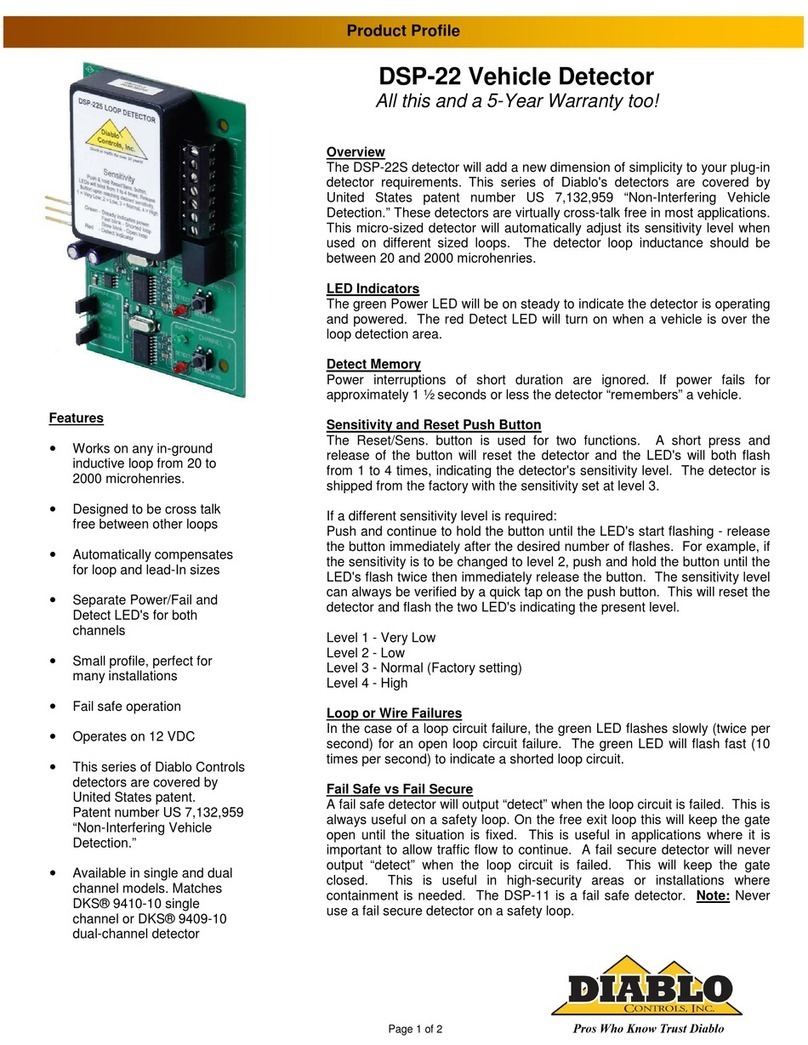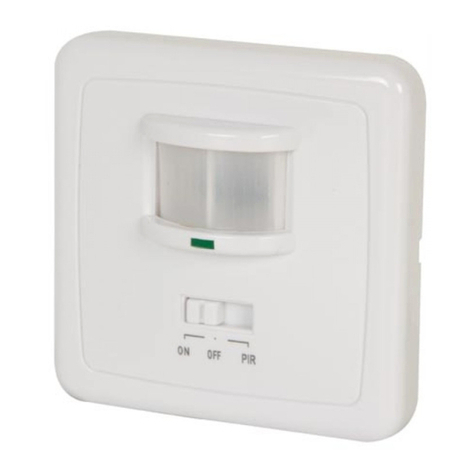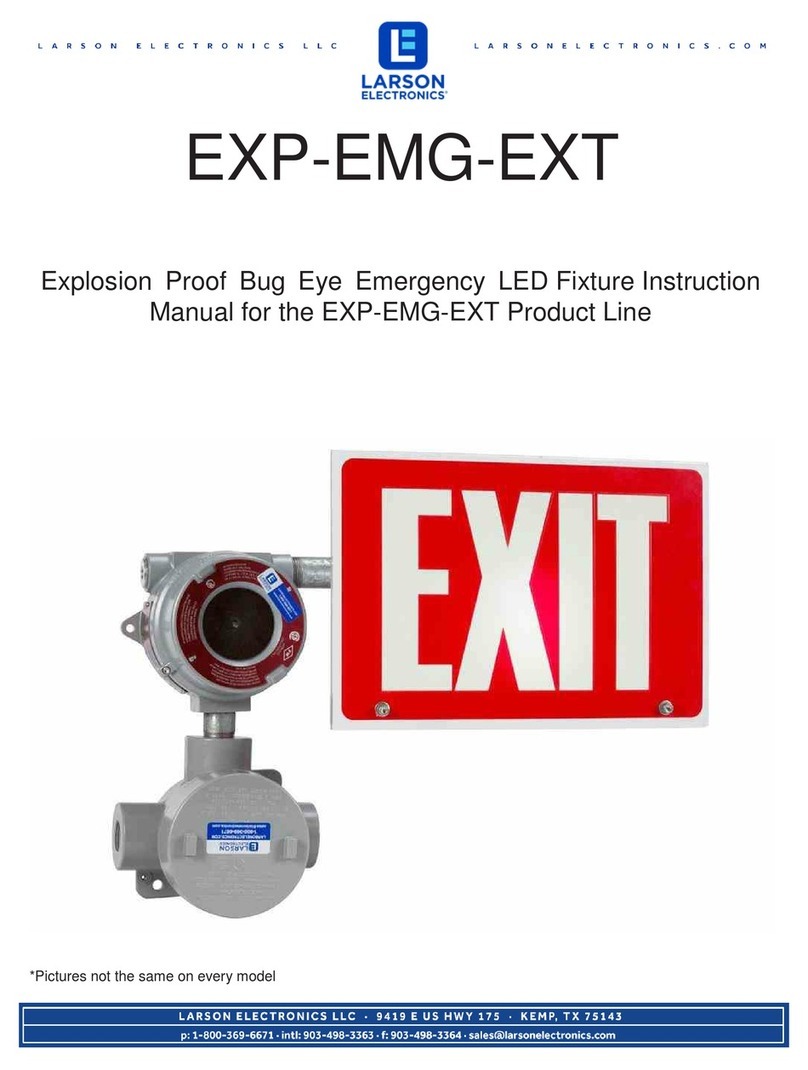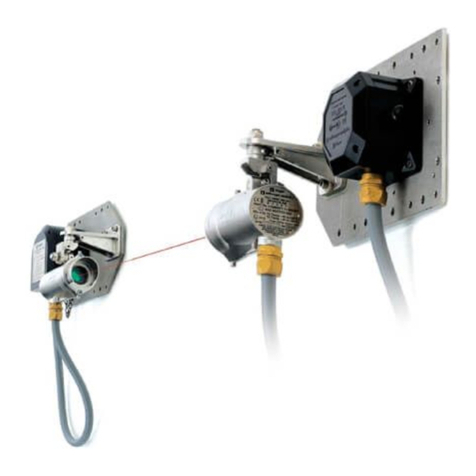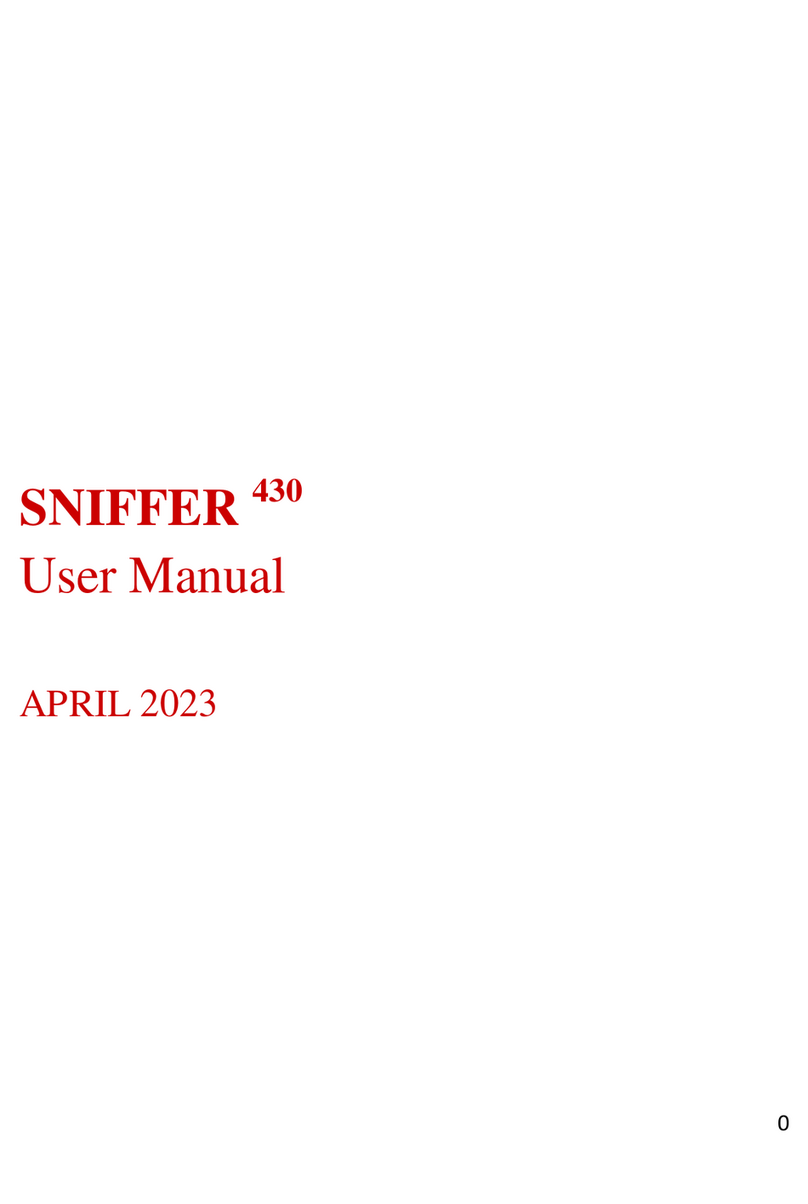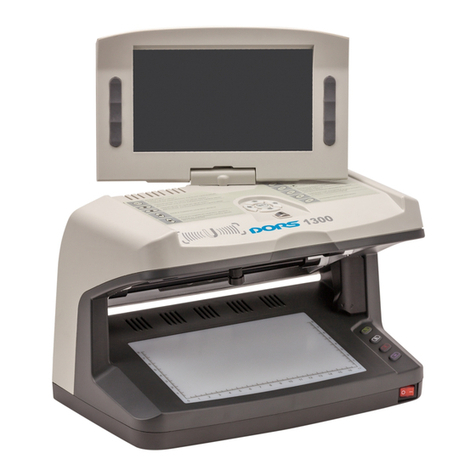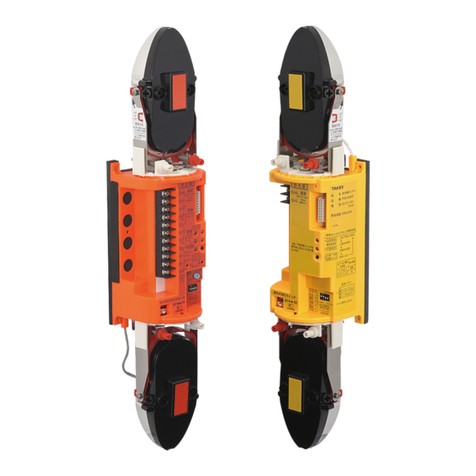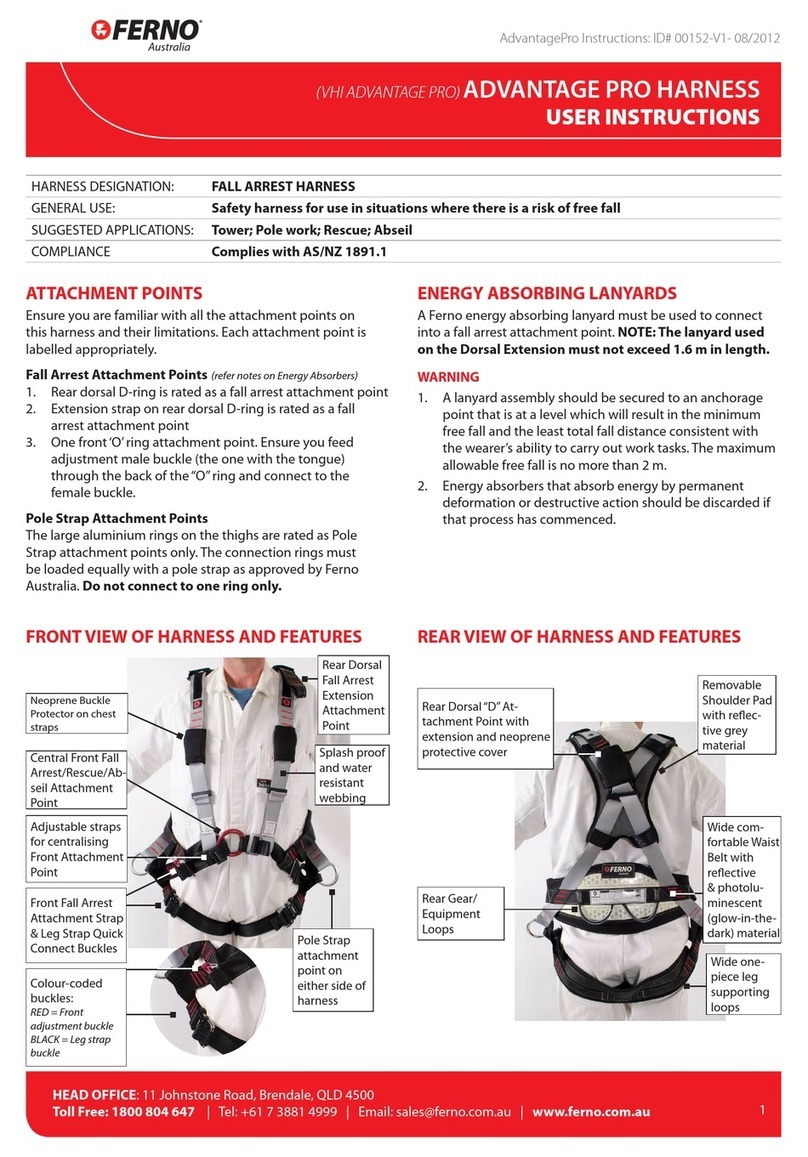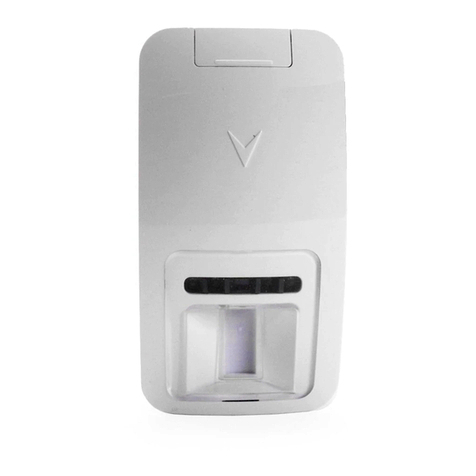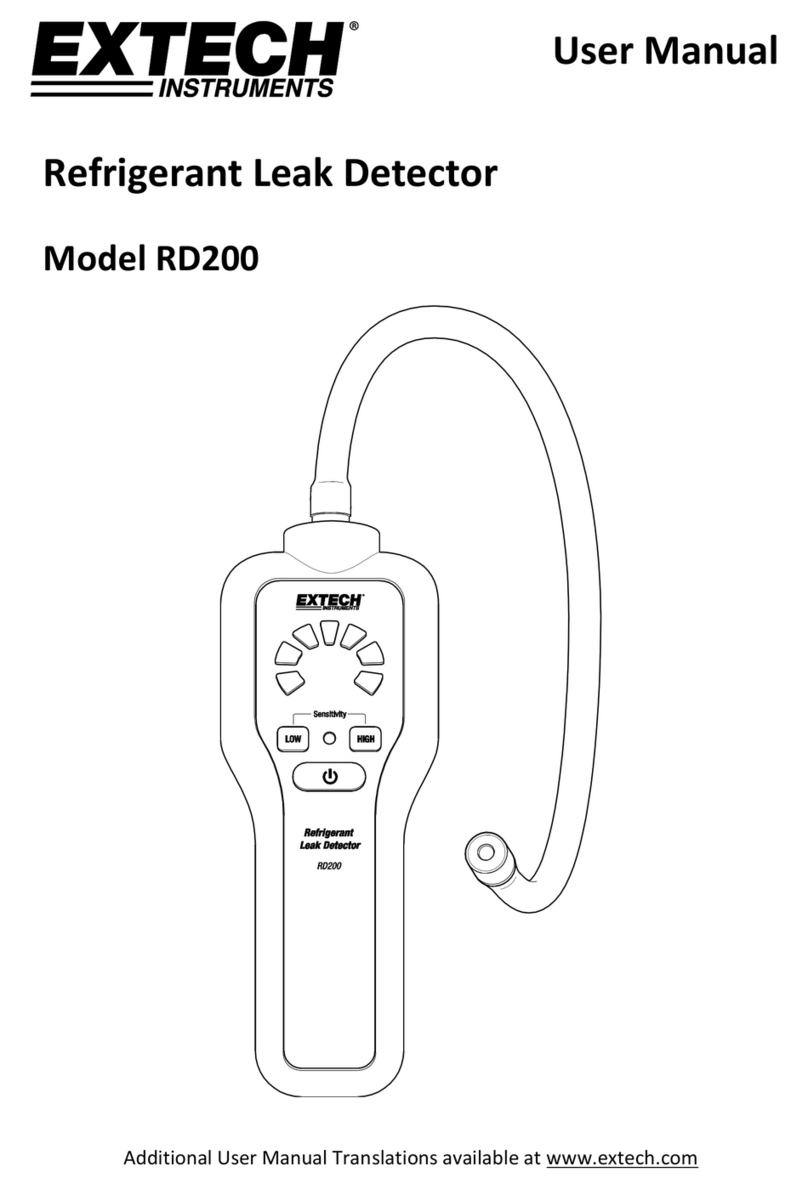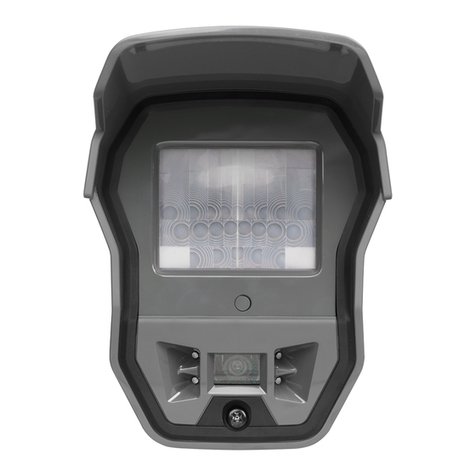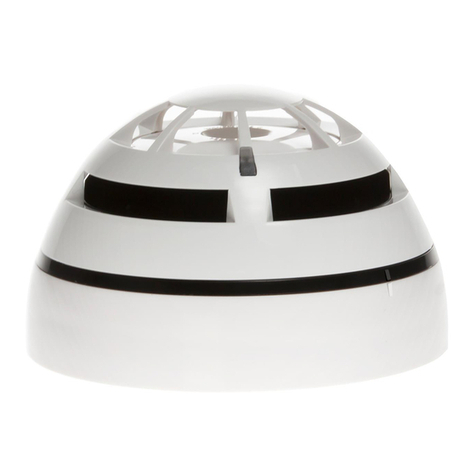Denios SpillGuard User manual

Technical changes reserved
Operating instructions
SpillGuard®
Output 2020-08
Original instructions

Copyright
DENIOS AG
Dehmer Straße 58-66
32549 Bad Oeynhausen
Tel. +49 5731 753-0
Fax +49 5731 753-199
Email info@denios.de
These instructions contain texts, images and drawings which need express written
authorisation before they can be reproduced, distributed or otherwise shared, in part or
in full.
These instructions represent the legal situation in Germany.
IMPORTANT
Read carefully before commissioning
Keep safe for later reference
© Copyright DENIOS AG

3 / 36
Table of contents
1Notes on the operating instructions .......................................................................................5
1.1 Warnings............................................................................................................................5
1.2 Instructions for use............................................................................................................7
1.3 Labelling.............................................................................................................................7
2Safety instructions ......................................................................................................................9
2.1 Intended use ....................................................................................................................10
Misuse .......................................................................................................................10
2.2 Operator duties ................................................................................................................11
Before commissioning...............................................................................................11
Obligation to inspect spill sumps .............................................................................12
Spill sump resistance................................................................................................12
Compliance with the requirements of the safety data sheet .................................12
Training......................................................................................................................13
Use in Ex zones - explosion protection requirements .............................................13
2.3 Personnel requirements ..................................................................................................15
3Transport and storage ..............................................................................................................16
3.1 Unpacking.........................................................................................................................16
4Product description ..................................................................................................................17
4.1 Overview ..........................................................................................................................17
4.2 Dimensions.......................................................................................................................19
4.3 Technical data..................................................................................................................20
Explanation of the nameplate ..................................................................................21
5Installation..................................................................................................................................22
5.1 Requirements for the installation location.....................................................................22
6Operation.....................................................................................................................................24
6.1 Commissioning the product.............................................................................................24

4 / 36
271081_SpillGuard_Operating-
instr_003_en.docx
6.2 Using the product in a new location...............................................................................25
6.3 Carrying out measures if the alarm is triggered ............................................................25
7Faults and incorrect operation...............................................................................................27
7.1 Possible faults..................................................................................................................27
8Maintenance ..............................................................................................................................29
9Decommissioning......................................................................................................................30
9.1 Switching off....................................................................................................................30
9.2 Cleaning ...........................................................................................................................31
10 Disposal.......................................................................................................................................32
11 EU conformity .............................................................................................................................33

Notes on the operating instructions
5 / 36
1Notes on the operating instructions
Before you set up and commission your product, ensure you read these operating
instructions completely. Always take note of the safety notices and warnings.
These operating instructions are for anyone who comes directly into contact with the
product.
These operating instructions form part of the product.
Further applicable documents
Depending on the product, you will receive the following documents separately as part
of your delivery:
Quick Guide
EU Declaration of Conformity (Download)
Resistance list (Download)
Differences are possible depending on country.
1.1 Warnings
Warnings are shown at the start of a chapter or section before instructions for use
where a hazard may occur. The warnings are structured as follows:

Notes on the operating instructions
6 / 36
271081_SpillGuard_Operating-
instr_003_en.docx
DANGER
The symbol shows the type of hazard.
Symbol and signal word show a hazard which leads to
serious injury or death.
Measure.
WARNING
The symbol shows the type of hazard.
Symbol and signal word show a hazard which can lead to
serious injury or death.
Measure.
CAUTION
The symbol shows the type of hazard.
Symbol and signal word show a hazard which can lead to
minor injury.
Measure.
NOTICE
Signal word shows a hazard which can lead to damage to property.

Notes on the operating instructions
7 / 36
Symbol shows instructions for use and other useful
information.
Pictograms are used to warn of hazards:
Pictogram Meaning
General warning
1.2 Instructions for use
These operating instructions contain various instructions for use.
Perform the following action
This is a requirement.
1. This is an action step.
This is an intermediate result.
2. This is another action step.
☑This is the final result.
1.3 Labelling
Italic text Is used to emphasise individual words or
phrases

Notes on the operating instructions
8 / 36
271081_SpillGuard_Operating-
instr_003_en.docx
Cross reference [7 ] Indicates that content is explained on another
page
NOTICE! Text.
CAUTION! Text.
WARNING! Text.
DANGER! Text.
Important information in the text, instructions for
use or tables
Important information for explosion protection
Refers to an audible signal after an action step
Refers to a visual signal after an action step
www.denios.com/spillguard
Further information available to download
LED

Safety instructions
9 / 36
2Safety instructions
This section gives important notices for safe use of the product. These notices are to
protect employees and to ensure safe, fault-free operation. Warnings relating to use
can be found in the corresponding instructions for use.
The product is built in accordance with the state of the art and the recognised technical
rules.
There may be hazards associated with the product if it is used, maintained or repaired in
an incorrect manner, not in accordance with the intended use or by untrained personnel.
Hazards may arise affecting:
Health and life of personnel
Product and other assets near the product
Follow all the safety instructions in these operating instructions as well as all safety
instructions in the operating instructions of our suppliers which have been provided.
Ensure that the national directives and safety regulations relating to hazardous
substances, safety directives, industrial safety and operator duties are observed.

Safety instructions
10 / 36
271081_SpillGuard_Operating-
instr_003_en.docx
2.1 Intended use
SpillGuard® is a mains-power-independent leak recognition system for detecting leaks
of liquids / liquid hazardous substances. SpillGuard® is designed for use in clean,
uncontaminated spill sumps, which are set up indoors.
The spill sumps should preferably be in metal or non-metallic (plastic) materials.
Outdoor use is not permitted.
SpillGuard® may only be used within the limits for use defined on the nameplate.
SpillGuard® is suitable for Ex zone 0, due to gases and vapours.
SpillGuard® may only be used as a precaution with the liquids which have already been
positively tested by DENIOS. The list can be found here:
www.denios.com/spillguard
Suitability must be tested for substances which are not in the list.
The resistance list contains a representative selection of liquid
hazardous substances. If required, DENIOS can carry out a
function and resistance test for your substance. The test
includes checking that the substance is correctly detected and
also that the alarm signal is then maintained for 24 h
(resistance test).
Misuse
DENIOS takes no responsibility for any damage caused by contravention of the intended
use. All warranties and guarantees are excluded in the event of misuse. The party
causing the misuse is solely responsible for any consequential damage.

Safety instructions
11 / 36
The following are considered as not in accordance with the intended use:
Using SpillGuard® in spill sumps for storing non-approved media
Using SpillGuard® in potentially explosive areas outside the nameplate limits
Using SpillGuard® in potentially explosive areas caused by dust
Using SpillGuard® again after a leaked substance has been successfully detected
Using substances which are not suitable for use with SpillGuard® :
www.denios.com/spillguard
Disregarding applications which are expressly described as permitted
Changing the battery
WARNING! If the housing is opened in Ex atmospheres there is a risk of
explosion. Opening the housing can lead to severe injuries or death.
Opening the housing is prohibited.
2.2 Operator duties
Before commissioning
Check the product for damage.

Safety instructions
12 / 36
271081_SpillGuard_Operating-
instr_003_en.docx
Obligation to inspect spill sumps
SpillGuard® is an additional safety measure, which indicates a leak using a visible and
an audible signal.
Regardless of using SpillGuard® the operator of containment devices is obliged to carry
out and document the weekly visual inspections required by the steel spill sump
guidelines (Stawa R) and the General Technical Approval.
Use of SpillGuard® does not mean that the operator of the equipment is no longer
required to comply with this obligation.
Spill sump resistance
The corrosion resistance of the materials used to make the spill
sump and their compatibility with the substances stored must
be demonstrated.
For many chemical substances steel spill sumps (1.0038) may be used. Plastic
(polyethylene) spill sumps are frequently required if corrosive substances (acids /
alkalis) are being stored. Stainless steel offers the best protection, especially against
many aggressive liquids. If no information is given in the resistance lists, the material of
the spill sump may be the same material as the transport container.
Compliance with the requirements of the safety data sheet
A safety data sheet must be prepared by the distributor for each hazardous substance,
in accordance with REACH legislation.
As the operator, you must observe the safety and hazard information in the safety data
sheet.

Safety instructions
13 / 36
Training
Personnel in question must be sufficiently trained at regular intervals, and especially if
changes or adjustments are made. Employees must be trained when the product is used
in Ex zone 0, especially on the measures for the avoidance of explosion hazards set out
in the risk assessment and explosion protection document.
Use in Ex zones - explosion protection requirements
Storage systems for flammable liquids are systems requiring monitoring within the
meaning of the Product Safety Act (ProdSG) § 2 Para. 30 with explosion hazard. The
requirements to be derived from this are described in the applicable technical rules for
the German Industrial safety regulations (BetrSichV) and the Hazardous substance
regulations (GefStoffV). According to the German Industrial safety regulations
(BetrSichV), the operator of this equipment is obliged to carry out a risk assessment. In
addition, the operator is obliged to produce an explosion protection document in which
appropriate protective measures are defined in order to avoid explosion hazards.
In addition, Directive 1999/92/EC sets out the minimum regulations for improving work
health and safety for employees who may be at risk due to explosive atmospheres. The
main contents are:
Duty of coordination
Explosion protection document
Classification of areas where an explosive atmosphere may be present

Safety instructions
14 / 36
271081_SpillGuard_Operating-
instr_003_en.docx
Minimum regulations for improving work health and safety for employees who may
be at risk due to explosive atmospheres as well as criteria for selecting equipment
and protection systems
The explosion protection document produced by the operator specifies the conditions at
the location of use. The operator must test in detail whether the product meet the
requirements of the explosion protection document.
The product is to be included in the preparation of the explosion protection document
and the measures it contains.
Further additional operator measures also include:
Include the storage system in the local equipotential bonding measures to avoid
electrical compensation currents.
The same applies for the avoidance of sources of ignition, discharge of static
electricity, connection to the equipotential bonding system is required here.
If the containers are filled with flammable liquids on the system components:
consider the additional measures regarding discharge of static electricity in
accordance with TRGS 727.
To comply with the discharge values, keep the bearing surface free of paint
residues, hazardous material residues or unwanted insulation.
Operate the storage system so that process-related electrostatic charges are ruled
out (e.g. from cleaning work, see also TRGS 727 Sections 4 and 5).

Safety instructions
15 / 36
2.3 Personnel requirements
Risk-free working is only possible, when only specially qualified personnel set up and
use the product.
Persons undergoing training may only be permitted to work with the product, if a
qualified person is constantly supervising the work.

Transport and storage
16 / 36
271081_SpillGuard_Operating-
instr_003_en.docx
3Transport and storage
The product is supplied in a cardboard pack together with a Quick Guide and inlay sheet.
Store the product as follows:
Dry
At room temperature
NOT outdoors
NOT in direct sunlight
3.1 Unpacking
Perform the following action
The pack is not damaged.
1. Open the cardboard pack.
2. Remove the contents.
3. Keep the Quick Guide to hand near the
product.

Product description
17 / 36
4Product description
4.1 Overview
Fig. 1: Top view
1
2

Product description
18 / 36
271081_SpillGuard_Operating-
instr_003_en.docx
Fig. 2: Bottom view
Element Function
1 “Red” LED
The “red” LED illuminates during commissioning,
operation and when an alarm is triggered.
2 Push button The push button is used to switch SpillGuard® on and off
and also to turn off the signal when an alarm has been
triggered.
3 Sensor
surface
If the sensor surface becomes wet, it detects a leak and
triggers the audible and visible signal.
4 Foot The different height feet ensure the product is stable. The
different height feet ensure that a leaked liquid reaches
the sensor surface without any bubbles.
3
4
Push
LED

Product description
19 / 36
4.2 Dimensions
Fig. 3: Dimensions in mm

Product description
20 / 36
271081_SpillGuard_Operating-
instr_003_en.docx
4.3 Technical data
Description Value
Dimensions ∅110 mm, height 40 mm
Operational temperature range 0 °C to a maximum of 40 °C
Temperature class T4 (max.135 °C)
Explosion protection group II B
Ignition protection type Intrinsically safe
Equipment category 1G
Weight 140 g
Nominal voltage 3.6 V
Lifespan Max. 5 years
Liquid level required to wet the sensor 6 mm
Noise in accordance with DIN EN ISO 3744 91.6 dB (A)
EC type examination certificate BVS 19 ATEX E 077
IECEx BVS 19.0073
FM certificate FM 20 US 0051
FM 20 CA 0023
The recommended operational temperature range is the
basis for the specified service life of 5 years. SpillGuard®
may also be used at a temperature down to max. -10°C. The
specified service life of 5 years cannot be guaranteed
however in this temperature range. Repeated false alarms
can be triggered if the temperature fluctuates around the
dew point.
Other manuals for SpillGuard
2
Table of contents
Other Denios Security Sensor manuals
